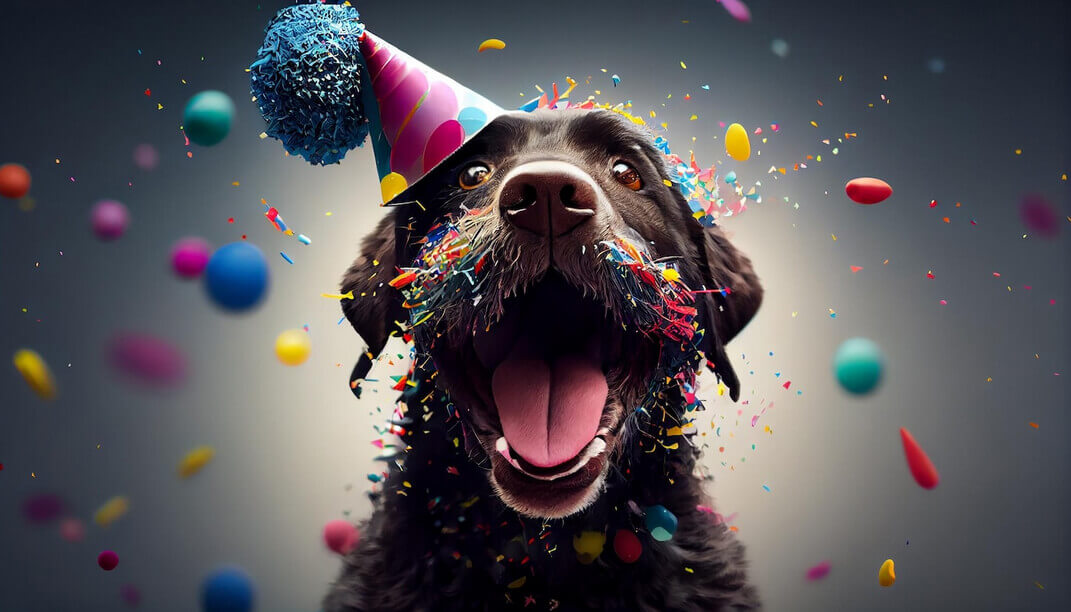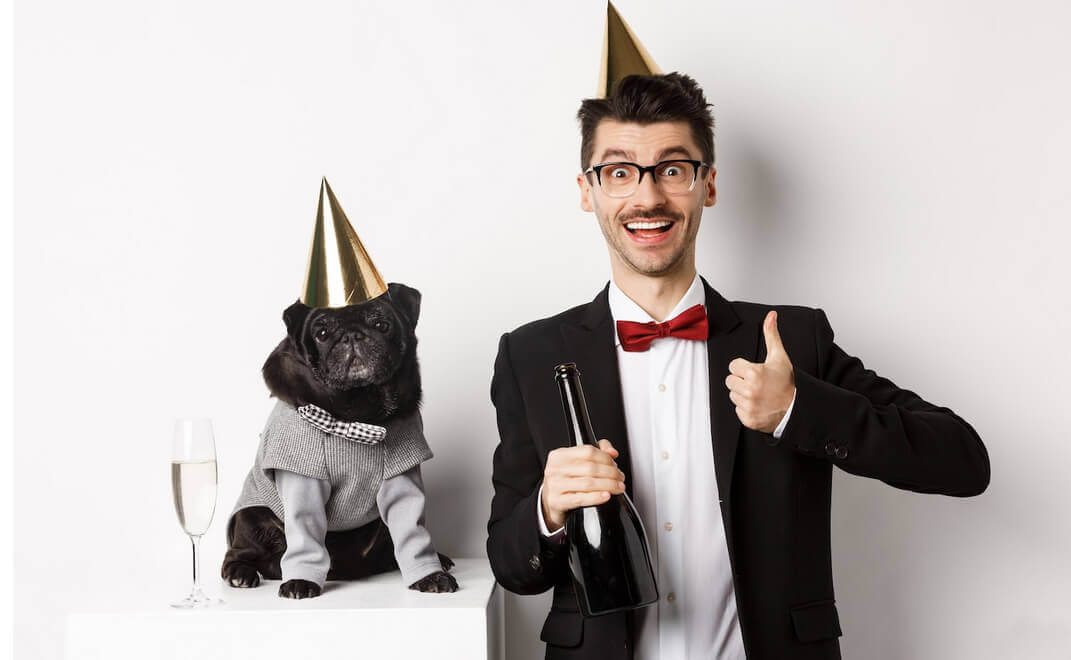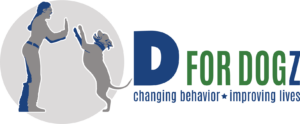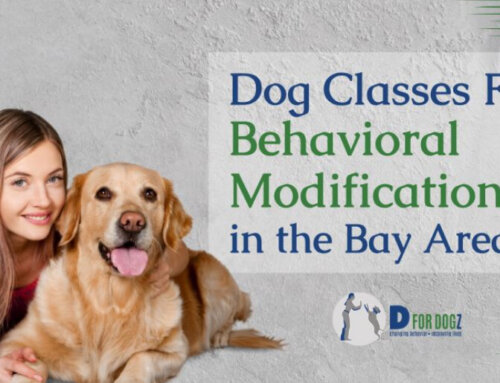
Ahhh, the Fourth of July is just around the corner. It’s a great day to celebrate with family and friends. Patriotic colors, celebration, barbecue, and fireworks!!!
While we might be having fun on this American holiday, we may have a dog who is less in the mood for celebration.
Did you know more pets are lost on July Fourth than on any other day? Some dogs are spooked by the loud whizzes caused by fireworks. Those not secured indoors end up bolting in fear. The Animal Poison Control Center (APCC) sees an increase in calls concerning pets who have ingested fireworks or are having issues with the loud noises of fireworks.
Have you considered consulting with a professional to get your dog the help he needs, but life intervened? While desensitization and counter-conditioning under the guidance of a qualified professional is the only route to help your dog, here’s a survival guide to “manage” the situation and keep our companion dogs safe:
Understanding Your Dog’s Fear of Fireworks

Fireworks, while a spectacle for humans, often spell distress for our canine companions. The reasons behind this fear are multifaceted and deeply rooted in dogs’ sensory and psychological experiences.
Sensory Overload
Dogs possess remarkable hearing capabilities, with the ability to detect a wide range of frequencies and sounds, often far beyond human capacity. Their acute hearing allows them to perceive subtle noises and locate sources with precision, making them highly attuned to their environment.
This heightened sensitivity makes fireworks’ loud and unexpected sounds startling and potentially perceived as threats. This is compounded by the fact that fireworks produce odors and visual stimuli that can be unsettling for dogs, contributing to an environment that can overwhelm their senses.
Psychological Impact
The unpredictable nature of fireworks—both in timing and intensity—can trigger a dog’s fight-or-flight response. Unlike natural phenomena such as thunderstorms, which provide pre-event cues like barometric pressure changes and wind alterations, fireworks occur without warning. This lack of predictability makes it challenging for dogs to adapt to these sounds, often leaving them in a state of heightened anxiety or fear.
Signs of Anxiety
Recognizing the signs of anxiety in your dog during fireworks is crucial for providing timely and effective support. Symptoms can range from visible distress signals such as panting, drooling, and pacing, to more severe reactions like attempting to escape, destructive behavior, or even aggression. In cases of separation anxiety, behaviors may include urinating or defecating in the house, excessive barking, and restlessness.
Addressing Fireworks Anxiety
Understanding and mitigating your dog’s fear of fireworks involves a combination of preparation, behavioral training, and possibly medical intervention:
- Preparation: Ensuring your dog feels safe during fireworks can involve creating a quiet space away from the noise or using calming products like thunder shirts that provide security through gentle pressure.
- Behavioral Training: Techniques such as desensitization, in which your dog is gradually exposed to the sounds of fireworks at a low level, can help it become less reactive over time.
- Medical Interventions: In severe cases, consulting with a veterinarian about anxiety medication or natural therapies may be necessary to help your dog manage their stress during fireworks events.
Taking proactive steps to understand and address your dog’s fear of fireworks can significantly enhance their well-being and allow you and your pet to enjoy festivities with greater peace of mind.
Pre-Event Preparation for Your Dog

Image Source: Freepik
For dog owners, preparation is key to ensuring their furry friends are safe and comfortable amidst the loud fireworks. Here’s how you can prepare your dog for the event:
Update Identification and Microchip Information
Before the fireworks begin, ensure your dog’s identification is current. This includes checking that their collar tags are secure and legible and confirming that the registered information is current if your dog is microchipped. This step is crucial as it increases the chances of your dog being returned to you should they manage to escape due to fear.
Create a Safe and Quiet Space
Identify a quiet, comfortable space where your dog can retreat from the noise in your home. This area should be away from windows and as insulated from sound as possible. Consider places like a basement or an interior room where the sound of fireworks is less likely to penetrate.
Making this space familiar and comforting by including your dog’s favorite bed, toys, and an item of clothing with your scent helps soothe them. Playing soft music or using a white noise machine can also mask the sounds of fireworks.
Gradual Desensitization
For long-term preparation, consider desensitizing your dog to the sounds of fireworks. This involves playing recordings of fireworks at low volumes and gradually increasing the volume over time, allowing your dog to acclimate to the sounds in a controlled environment. This method requires patience and should be done over weeks or months before the fireworks event.
Positive reinforcement, such as treats and praise when your dog remains calm, can aid in this process.
Consultation with a Veterinarian
If your dog has a history of severe anxiety, a consultation with your veterinarian might be necessary. They can provide advice on additional strategies to manage anxiety, which may include prescription medications or over-the-counter calming aids to help your dog cope during particularly stressful events like fireworks.
Practice the Plan
Once you have set up a safe space and considered all preparatory steps, practicing the plan before the event is beneficial. This will help you identify any potential issues or adjustments needed to ensure your dog’s comfort and safety when the fireworks begin.
During the Celebration: Keeping Your Dog Calm

Image Source: Freepik
The Fourth of July is synonymous with fireworks and festivities that can last night. For dog owners, this period requires vigilance and proactive measures to ensure their pets remain calm and secure. Here’s how to care for your dog during the fireworks:
Stay Indoors
The simplest yet most effective way to protect your dog is to keep them indoors. This reduces their exposure to the loud noises that can cause panic. If your dog needs to go outside, make sure it’s for a brief period, and consider using a leash, even in enclosed spaces, to prevent them from running off in fear.
Provide Distractions
Distractions can play a crucial role in keeping your dog calm. Engage them with their favorite toys or initiate playtime activities that divert their attention from outside noise. Interactive toys that stimulate their mind can be particularly effective. Additionally, consider feeding them a special treat or engaging in a training session to keep their mind occupied.
Use Calming Aids
Various calming aids are available to help soothe your dog’s nerves. This includes products like anxiety vests, which apply gentle pressure to your dog’s torso, mimicking the comfort of being held. Pheromone diffusers, sprays, and calming treats can also be beneficial. These aids work by emitting substances that mimic the pheromones mother dogs produce to calm their puppies, thereby reducing anxiety in dogs.
Maintain a Calm Demeanor
Dogs are highly perceptive and can pick up on their owners’ emotions. Displaying calm can help reassure your dog that there’s nothing to fear. Avoid overreacting to the fireworks yourself, as this can heighten your dog’s anxiety. Instead, maintain a regular routine to provide a sense of security.
Consider Safe Spaces
If you’ve prepared a safe space for your dog, guide them there at the start of the fireworks. This might be a room with closed windows and curtains to muffle the sound and block out the flashes of light. Ensure they have access to their bed and water, and leave the television or radio on at a normal volume to help drown out the fireworks. Your presence in this safe space can also be a significant source of comfort.
Alternative Solutions for Anxiety Management

Image Source: Pexels
Several alternative solutions can help dogs that are particularly sensitive to fireworks and may require more than just distractions and a safe space to manage their anxiety more effectively. These methods can offer relief and comfort to dogs who experience heightened stress levels during noisy celebrations.
Consultation with a Veterinarian
If your dog’s anxiety is severe, it’s advisable to consult with a veterinarian. They can assess your dog’s specific needs and may prescribe medication to help manage their anxiety. Medications such as sedatives or anti-anxiety drugs can be effective for short-term relief during fireworks and similar stressful events. Following your vet’s guidance closely when administering these medicationsis important.
Natural Remedies and Supplements
In addition to or instead of prescription medications, natural remedies and supplements can help calm an anxious dog. Options include:
- Herbal supplements
- CBD oil (derived from hemp and not containing THC)
- Products designed to mimic calming pheromones
While these can be effective, it’s essential to research and possibly consult your vet to ensure they’re safe and suitable for your pet
Calming Accessories
Products like calming collars, anxiety vests, and even specially designed toys can provide comfort and reduce anxiety. Anxiety vests work by applying gentle pressure to your dog’s body, which can have a calming effect similar to swaddling a baby.
Calming collars release pheromones that mimic those mother dogs produce to calm their puppies. Always introduce these accessories well before the stressful event to ensure your dog is comfortable.
Environmental Modifications
Creating a calming environment can also significantly reduce stress levels in dogs. This might include playing soft, soothing music or using sound insulation techniques to reduce the impact of fireworks. Blackout curtains can help block out the flashes of light from fireworks, making the environment more soothing for your dog.
Behavior Modification Training
Behavior modification training can be a long-term solution for managing anxiety. Techniques such as desensitization and counter-conditioning can help your dog become accustomed to loud noises in a controlled, gradual manner. This training often involves playing recorded sounds of fireworks at low volumes and gradually increasing the volume over time, all while providing positive reinforcement to your dog.
Professional dog trainers or animal behaviorists can assist with these techniques, ensuring they’re implemented safely and effectively.
Post-Event Check and Care

Image Source: Freepik
After the fireworks and celebrations have concluded, following up with care and observation is important to ensure your dog recovers from any stress or anxiety they may have experienced. Here are steps to consider for post-event care:
Conduct a Physical and Behavioral Check
Once the noise has died down, assess your dog for any signs of physical injury or stress. This includes checking for any cuts or bruises that might have occurred if they attempted to escape or hide in a small space.
Behaviorally, observe your dog for any lingering signs of anxiety, such as continued pacing, shaking, or hiding. Any prolonged stress behaviors warrant a consultation with your veterinarian.
Re-establish Routine
Dogs thrive on routine, and re-establishing their normal schedule as soon as possible can help them recover from the event’s stress. This includes regular feeding times, walks, and play sessions. Returning to a predictable routine can provide a sense of security and help ease any lingering anxiety.
Provide Comfort and Reassurance
Providing comfort and reassurance to your dog after the event can help them calm down more quickly. This might involve extra cuddles, gentle petting, or quiet time together. It’s important to let your dog decide when they’re ready to interact more or resume normal activities; some may need extra time to relax fully.
Monitor for Delayed Reactions
In some cases, dogs may exhibit delayed reactions to stress. This could manifest as changes in eating habits, sleep patterns, or general behavior in the days following the fireworks. Keeping a close eye on your dog and noting any significant changes can help you address any issues promptly. If you notice any concerning changes, don’t hesitate to contact your veterinarian for advice.
Consider Professional Help if Needed
If your dog shows signs of severe or prolonged anxiety, it may be beneficial to seek professional help. This could include consulting with a veterinarian about possible medical interventions or working with a professional dog trainer or animal behaviorist to address underlying anxiety issues. They can offer tailored strategies and support to help your dog cope more effectively with similar situations in the future.
Summary
| Phase | Tips | Explanation | |
| Before the Event (Preparation) | Update Identification | Ensure your dog’s collar tags are secure and legible, and microchip information is current to increase the chances of being reunited if they escape. | |
| Create a Safe and Quiet Space | Set up a quiet area away from windows and noise, using familiar items like their bed or toys to make it comforting. Soft music or white noise can help mask the sound of fireworks. | ||
| Gradual Desensitization | Play recordings of fireworks at low volumes, gradually increasing them over time, allowing your dog to acclimate to the sounds in a controlled manner. Positive reinforcement helps during this process. | ||
| Consult a Veterinarian | For dogs with severe anxiety, consulting a vet for advice on anxiety management, including possible prescription medications or calming aids, is advisable. | ||
| Practice the Plan | Test your preparations before the event to make necessary adjustments, ensuring your dog’s comfort and safety during fireworks. | ||
| During the Event (Celebration) | Stay Indoors | Keeping your dog inside reduces their exposure to the loud noises of fireworks, preventing panic and escape attempts. | |
| Provide Distractions | Use toys, playtime, or special treats to keep your dog’s mind off the noise. Interactive toys that stimulate their mind can be especially effective. | ||
| Use Calming Aids | Anxiety vests, pheromone diffusers, and calming treats can offer additional comfort by mimicking the calming effect of being held or the presence of a mother dog. | ||
| Maintain a Calm Demeanor | Dogs can sense their owners’ emotions; staying calm and composed reassures them that there’s nothing to fear. | ||
| Consider Safe Spaces | Utilize the prepared quiet space with familiar comforts, possibly adding white noise or soft music to further drown out the sound of fireworks. Your presence can be a significant source of comfort. | ||
| After the Event (Post-Event Care) | Physical and Behavioral Check | Assess your dog for any signs of stress, injury, or behavior changes post-celebration. Prolonged stress behaviors may require veterinary consultation. | |
| Re-establish Routine | Quickly returning to regular feeding, walking, and play schedules can help alleviate any lingering anxiety by providing a sense of normalcy and security. | ||
| Provide Comfort and Reassurance | Continue offering affection and reassurance to help your dog calm down. Some dogs may need additional time to relax fully after the event. | ||
| Monitor for Delayed Reactions | Be alert for any delayed stress responses, such as changes in eating or sleeping patterns, and consult a veterinarian if you observe concerning behaviors. | ||
| Professional Help if Needed | If severe or prolonged anxiety signs are observed, consider seeking help from a veterinarian or professional dog trainer to address underlying issues and prevent future distress. | ||
About the Author: Kaajal Tiwary
Kaajal (aka “KT”!) loves puppies and is dedicated to getting new puppy guardians off on the right paw and guiding her students through the tough early days of owning a dog. Her goal? Transforming each bundle of raw puppy energy into the perfect adult companion.















